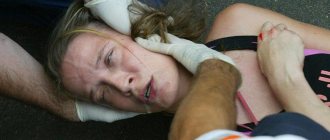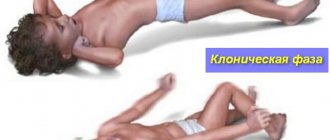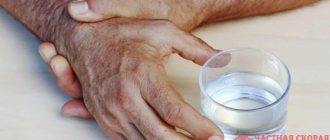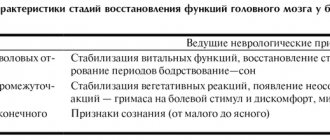No person is immune from injury. Anyone can, for example, trip and fall or hit their head. But almost any blow to the head in a certain way affects the state of the body; it can cause the development of dangerous pathologies. Thus, a blow to the temple can have unpredictable consequences, even death. Not everyone knows why this happens. Meanwhile, the temple is the most vulnerable area of the head; it is here that the brain is not sufficiently protected. That’s why our parents tell us from childhood that hitting us on the head is absolutely forbidden.
Why is this dangerous?
The temporal region is the most vulnerable part of the head. A blow to the temple can have serious consequences, ranging from concussion to death. Many nerve endings pass through this area and lead to other areas of the head, such as the eye sockets. In addition, the temporal bone is quite fragile, so it can break upon impact.
Also in the temporal region passes the temporal artery. A small blow is enough to cause a fracture of the bone plate, as well as a rupture of the artery, which is the most significant of all those that feed the dura mater of the brain.
Why is a blow to the temple dangerous? Trauma can lead to the following consequences:
- Paralysis of limbs.
- Aneurysm.
- Bleeding in the brain.
- Epilepsy.
- Concussion.
- Loss of vision.
- Death.
Thus, the anatomical structure of the human head, in particular the temporal region, suggests the development of health and life-threatening consequences when it is injured. Therefore, the answer to the question of why a person dies from a blow to the temple is obvious.
Why is a blow to the temple dangerous?
The temples are a paired area of the head, which is located between the ear, forehead and cheekbone line. It is represented by the temporal cavity, formed at the junction of the sphenoid and temporal bones. The temporal bone itself is one of the thinnest and weakest ( about 2 mm ) and is easily susceptible to fractures.
In the area of the temporal region there is the meningeal (temporal) artery, which supplies the hard part of the brain . The vagus nerve is also localized there , which is responsible for the work of many muscles, including the heart and a large number of nerve fibers. a layer of fiber under the skin , but it is very loose and does not provide much protection upon impact. The skin on the temples is thin and easily susceptible to tearing and injury.
Symptoms and signs
The consequences of damage to the temporal region may not appear immediately. The first symptoms sometimes appear after two or three days. A person feels a headache, which can be easily relieved with painkillers. But sometimes it can get worse, the medications stop helping, and tinnitus appears. Over time, the pain is strongly felt in the temporal region, problems arise in the functionality of the neck, bruises appear under the eyes, vision and speech are impaired. A person may feel nauseous and dizzy, and lose consciousness. These symptoms may indicate a concussion or other health problems, so it is important to seek medical help immediately.
The following signs should alert you:
- Prolonged headaches that do not go away for three days.
- Inability to eliminate pain with medications.
- Noise in ears.
- Impaired coordination of movements.
- Visual impairment.
- Photophobia.
- The appearance of convulsions, hallucinations.
If immediately after a blow to the temple the consequences begin to appear, you need to urgently call an ambulance.
Classification of TBI by severity
There is a special Glasgow scale. It helps determine the severity of the head injury. Experts conduct tests and evaluate:
- motor reactions;
- speech reactions;
- opening the eyes.
For each test, points are awarded and summed up:
- 14-16 - mild degree;
- 9-13 - average;
- 8 - heavy;
- 3 or less - deep coma.
Regardless of the severity of the injury, it is important to seek help promptly. Timely and adequate therapy reduces the risk of complications and improves the prognosis.
First aid
Adult concussion symptoms and treatment are closely related. The doctor will tell you about this in detail. But before the ambulance arrives, it is necessary to provide first aid to the victim. First of all, cold is applied to the affected area if the injury is closed. If there is bleeding, apply a gauze pad to the wound and carefully bandage the head. Do not touch or remove bone fragments that protrude from the wound.
Treatment for loss of consciousness should begin with the person being placed on their side to prevent them from choking on vomit if they vomit. The head and shoulders must be positioned so that they are slightly higher than the body. It is recommended to fix them. It is necessary to check the person’s pulse and breathing; if they are absent, resuscitation measures must be carried out: artificial respiration, cardiac massage.
If the victim is conscious, he should not move until paramedics arrive. The person needs to be calmed down. The victim is transported to the clinic in a supine position.
How to cope with pain on your own
If a person has injured his head, he may experience pain for some time. Some people find tea with mint and honey and proper rest helpful.
In addition, it would be a good idea to take a warm bath with some relaxing essential oil added.
If it is not possible to take a bath, then you can pour water into a container, drop a little oil into it and place the bowl next to your head.
When the blow hits your temple, you should apply cold to it. For example, an ice cube or a piece of meat from the freezer, wrapped in a soft cloth.
In addition, cabbage leaves taken in the refrigerator will cope well with the problem.
To calm the nerves, you can perform a massage by kneading the temples, forehead, back of the head and neck.
Among medications, healing ointments are allowed. For example, Diclofenac or Fastum Gel.
Diagnostic measures
Even with a light blow to the temple, the consequences can be unpredictable. Therefore, it is recommended to undergo examination by such specialists as a therapist, neurologist, or surgeon. Self-medication is strictly prohibited.
The doctor must eliminate the risk of developing dangerous injuries. For this purpose the following is carried out:
- X-ray of the head bones.
- CT or MRI of the brain (the price may vary slightly in different clinics) to exclude internal bleeding and hematoma, identify changes in the brain, and diagnose complications.
The doctor also conducts a study of vision and hearing, tactile sensations, coordination of movements, balance, and reflexes.
In some cases, the doctor may send the victim home under the supervision of relatives. Relatives should monitor the patient throughout the day, and they should periodically awaken the victim in order to determine whether he wakes up normally. Adult concussion symptoms and treatment are interrelated. If unpleasant symptoms occur or worsen, hospitalization is required.
While under home observation, the patient must remain in bed, avoid overexertion and physical activity, and do not strain the eyesight.
Types of temporal bone fracture
A blow to the left or right temple area is dangerous. In this zone there is the thinnest bone, only 2 mm thick, and there is practically no soft tissue. Therefore, there is a high probability that there will be a fracture of the temporal bone and displacement of the skull bones. This zone contains the vestibular and auditory apparatus, the trigeminal ganglion, part of the sigmoid sinus, and the carotid artery.
If you hit the temple when hit, you can kill a person or make him disabled. Therefore, you cannot hit or accidentally get into this area.
Types of fractures depending on the location of their consequences:
- Temporal bone scales - compression of brain tissue, formation of fragments, severe internal bleeding.
- Pyramids of the temporal bone are a severe, often fatal injury with damage to the labyrinthine passage, accompanied by reversible or irreversible disorders of balance functions. After a punch, blood can enter the tympanic cavity of the middle ear, and sometimes cerebrospinal fluid leaks from the nasopharynx or ear.
- Depressed fracture. The consequences of a direct blow are accompanied by damage to brain tissue from fragments, hematomas and hemorrhages are formed. Brain functions are impaired and a person may die. Surgery required.
- Linear or longitudinal fracture. With a direct blow to the parietal-occipital region, fragments are rarely formed, but the functioning of the vestibular or auditory system is disrupted. A linear fracture is considered the least dangerous. There is a thin crack on the bone without displacement or splinters.
ICD-10 codes: S00 – superficial head injuries, S01 – open head wound. S02 – fracture of the skull and facial bones, S06 – intracranial injury, S07 – crushing of the head.
Why you shouldn't hit your temple
A blow to the temple can lead to death.
Any blow to the temporal region and even a strong click can cause disruption in the functioning of various parts of the brain and nervous system. This blow can kill you.
The most common consequences of a blow to the temple:
- concussion, a person may feel sick;
- hematomas, hemorrhage due to arterial rupture, aneurysm;
- the occurrence of a tumor;
- complete or partial paralysis of the facial nerve, impaired jaw function;
- epilepsy;
- loss of vision;
- deterioration of short-term memory;
- weakness, drowsiness, loss of appetite;
- prolonged loss of consciousness, coma;
- death.
The vagus nerve is located in the temporal region. If the nerve endings are hit during a blow, the heart may stop or the person may be paralyzed.
Consequences of a blow to the temporal region
One of the possible consequences is Parkinson's syndrome.
If you ignore the symptoms of injury for a long time and do not start treatment in time, serious complications may arise after a blow to the temple. The consequences may not appear immediately, but after several years.
Complications and consequences in adults and children:
- mental and vegetative disorders of an irreversible nature;
- memory problems, cognitive impairment;
- if the nerve is damaged, the mouth becomes distorted and the face becomes asymmetrical;
- complete or partial loss of mobility;
- Parkinson's syndrome, frequent attacks of epilepsy;
- atrophy of brain tissue;
- severe vascular damage.
An untreated head injury, especially if the second blow is in the same area, leads to severe headaches on the left or right, especially when weather conditions change or overwork. Often you have to constantly take analgesics or anticonvulsants.
Therapy
An MRI of the brain (the average price is two thousand rubles) will give an accurate picture of the disease. Depending on this, the doctor will develop a treatment regimen that will focus on:
- To improve metabolic processes in the brain.
- Strengthening vascular walls.
- Prevention of cerebral edema.
- Restoration of blood circulation.
- Relief of pain syndrome.
At the clinic, doctors will eliminate not the symptoms of the pathology, but its causes. Therefore, in case of injuries to the temporal region, it is recommended to remain in a medical facility for treatment. In severe cases, surgery may be required. In some cases, intracranial hematoma is drained.
In the absence of bleeding, conservative treatment is resorted to. The doctor may prescribe sedatives, painkillers, diuretics, muscle relaxants, and analgesics. Antibacterial and antiepileptic drugs are sometimes prescribed.
Complications and consequences
A blow to the temple can have the following consequences:
- Mental and autonomic disorders.
- Impaired sensitivity, rhea, vision and hearing.
- Limitation of mobility.
- Impaired memory and consciousness.
- Parkinson's syndrome, epilepsy.
- Brain atrophy.
- Vascular damage.
- Attachment of a secondary infection.
Forecast
The prognosis will depend on the severity and nature of the injury. In a mild case, the bruise does not lead to serious health problems, so the prognosis will be good. In severe cases, death can occur.
Complications after an injury are also possible. In this case, the victim is often forced to take anticonvulsants throughout his life. Sometimes the consequence of a bruise can be an irreversible mental disorder.
Prevention
A blow to the temple can have life-threatening consequences. In this area, the brain is most vulnerable, since the temporal bone is quite thin (two millimeters). Doctors recommend taking precautions. Do not get into fights, avoid extreme hobbies. Children need to be monitored especially closely, as they are the ones most susceptible to head injuries.
If a bruise does occur, you must immediately call an ambulance. The consequences of a bruise may not appear immediately, but after several days, so it is important to undergo prompt diagnosis and begin therapy to reduce the risk of developing dangerous consequences.
Traditional medicine
A compress made from potatoes, mashed to a pasty state, has a very good effect on the nervous system.
To do this, grate the potatoes, wrap them in gauze and place them on your temple. After this, it is recommended to lie down and rest a little.
You can use potato decoction, tomato and beet juice, a cocktail of parsley, sorrel and broccoli.
When an injury causes a drop in blood pressure, doctors recommend drinking motherwort or a decoction of St. John's wort.
It is worth considering that a person who has suffered a head injury may suffer from sudden changes in weather conditions and changes in atmospheric pressure.
Therefore, it is better to consult a doctor and follow all his recommendations.











